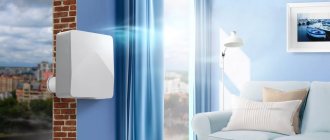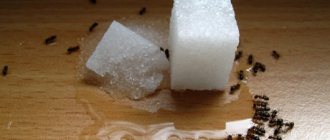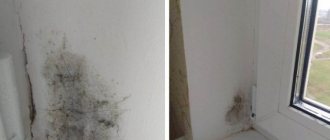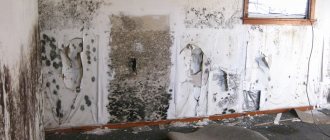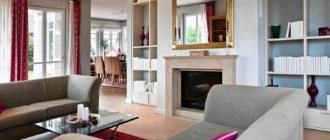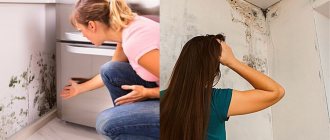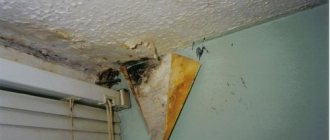Is it possible to remove mold permanently? If so, how can we do it better, faster and more securely? If not, what should I do? Why does it appear indoors, under what conditions, what are the dangers and what are the ways to get rid of it? We'll talk about all this in today's article.
Now the main questions are: if mold appears on the wall in an apartment, what to do, where to run, how to get rid of the scourge? We understand! Everything is correct! It causes a lot of inconvenience: it spoils the aesthetic appearance, destroys buildings, and, most importantly, harms your health!
Therefore, we destroy the fungus as soon as possible!
Types of mold on walls
Mold can vary in color or location:
- White - forms in flower vases and on bread that has been lying in dampness for too long, also occasionally found on wooden coverings, furniture, etc., can cause allergies.
- Green - appears on food products, making them unsuitable and dangerous for consumption, and also occasionally appears on building materials.
- Black is the most dangerous to health, can cause pulmonary diseases, including cancer, appears everywhere where there is dampness, affects wallpaper, tiles, walls and ceilings.
- Dull blue (blue) - appears on wooden furniture, parquet floors, window and door frames.
- Rotten - affects wood products, giving them a gray-brown color.
- Yellow - appears on rice seeds and other grains, fish, dairy products, nuts, compost, as well as in basements, ventilation and heating systems, etc. Very toxic to humans.
- “Noble” (red and blue) - specially created for dairy products (primarily cheeses), and is not dangerous to humans.
Mold locations
As a rule, mold appears in hard-to-reach places, combined with high humidity and low temperature. These are places where a housewife rarely looks or cannot clean up for a number of reasons. As a rule, black spots with a specific coating appear in such places.
The main places where fungal colonies appear:
- On the walls from the inside, if there is no normal layer of insulation or the insulation technology of the house is broken.
- At the joints of panels, as well as in the corners of rooms.
- In window sill areas.
- On the slopes.
- On wooden frames.
- On tile joints in bathrooms.
- On water pipes, if condensation accumulates on them.
HOW TO GET RID OF FUNGUS ON WALLS
How does mold appear on walls?
Molds love damp rooms. Dampness is the main factor in mold growth. Initially, mold spores are almost always present in the air of residential and non-residential premises.
When they find a damp or damp surface, they begin to multiply and create colonies of fungi, which people usually call mold.
- If the relative humidity exceeds 60%, a favorable environment for the development of mold is created, although this is not the main factor for its occurrence.
- The humidity of surfaces, especially wooden ones, should not exceed 5%. The number of degrees on the thermometer also matters.
- Mold develops most comfortably at temperatures from +4 to +20°C. Air circulation also plays an important role.
If the premises are poorly ventilated or there are problems with ventilation, this also favors the appearance of mold. Poor home heating and freezing of walls can also contribute to the appearance of fungal colonies on walls and ceilings.
Freezing of walls occurs, among other things, due to poor connection between the plaster and the wall, which is usually a mistake during the construction of a building.
Cracks in the walls, depressurization of panel seams, water leaks, problems with sewerage are also some of the reasons for the development of mold colonies. Also, if there are a lot of flowers in pots in the room, then if they are not properly cared for, mold will also grow in the pots.
What is mold called?
Microscopic fungal spores that surround us everywhere: in the soil, in the air, in rooms. By reproducing very quickly, they can create colonies that can be seen with the naked eye. It is the colonies that you will see in the house, and not single spores or hyphae (threads). They can be of different colors: whitish, black, gray-brown, and appear on objects and in the room itself, on windows and doors.
Mold spores are considered very harmful to human and pet health. Unnoticed, they can get not only onto the skin, but also into the respiratory tract, provoke various diseases and become the cause of prolonged allergies. Black mold is considered especially allergenic, which can lead to bronchial asthma.
Mold damage and first aid
Different types of mold can cause varying degrees of harm to the human body - from mild illness and allergies to severe pulmonary diseases, poisoning and even cancer.
- Yellow mold is the most dangerous, as it contains the poison aflatoxin, which is resistant to heat treatment and is very dangerous for humans.
- This poison can cause asthma, bronchitis, and cardiovascular diseases.
- White and green mold are not so dangerous, but they can also cause allergies and poisoning.
- Black mold can cause severe lung diseases, including cancer.
- Some types of mold can even cause death.
In case of mold damage, treatment is carried out with absorbent substances (for the gastrointestinal tract) and antifungal drugs. It is also necessary to support the functioning of the kidneys and liver and restore the intestinal microflora. For this purpose, special medications and a diet with the addition of natural antioxidants are prescribed.
Mold in the apartment: why it is dangerous to health
Mold is most dangerous for children, pregnant women and the elderly. Its spores spread through the air, infect new surfaces, and enter the human body.
Mold is most dangerous for people with:
- asthma
- allergies
- pneumonia
- frequent headaches
- depression
- inflammatory skin diseases
- and etc.
Constantly staying in an apartment with mold, a person’s colds and influenza last longer.
Mold also causes serious pathologies such as liver and kidney damage, and emphysema.
Many types of mold common in the CIS countries are pathogenic forms, that is, they are causative agents of various diseases.
It is not difficult to get rid of mold in the seams of a bathroom if it has not penetrated deep into the structure of the seams. Otherwise, it is easier and more efficient to remove the old grout and put in new one. If the seams are made of epoxy grout, they are not afraid of mold.
It is precisely because of the dangers listed above that if mold is found in an apartment, you should begin removing it yourself or resort to the help of cleaners.
Preventing mold on walls
There are some useful tips on how to prevent mold from growing in your home.
- Be sure to ventilate the room at least twice a day, morning and evening. Plastic double-glazed windows make it difficult to ventilate the room, so they need to be opened more often.
- Check the ventilation regularly, do not close it, and do not clutter the living spaces with unnecessary furniture so that the air can circulate freely. You can use air conditioners and fans, but do not get carried away with humidifiers. Special antimicrobial filters can be installed on air conditioners and fans.
- Check your sewer and heating systems regularly for leaks.
- In case of low heating, warm up the home with heating devices.
- Do not get carried away with drying clothes indoors.
- Check walls, floors and ceilings for cracks and leaks.
- It is advisable to have an electric hood in the kitchen, since the air also becomes very humid when cooking.
- Do not store bread and flour products for too long, especially in high humidity.
- To prevent mold, as well as to combat existing colonies of fungi, you can use ultraviolet lamps.
Try not to spend too much time in the bathroom, dry the room thoroughly after taking a shower, and do not store wet towels, sponges and other hygiene items.
How to remove the smell of dampness in the house
The appearance of mold is accompanied by an unpleasant odor. And often, even after removing the source, the room continues to smell damp and rotten. That is why many apartment owners ask the question: “ how to get rid of the smell of dampness in an apartment?”
If you still notice the smell of mold a few days after treatment, you can sprinkle baking soda on the surfaces where the stains were.
This is an excellent odor absorber. The baking soda can be left overnight and then collected using a vacuum cleaner. After a few days, the procedure can be repeated. In addition, you should place charcoal briquettes around the house.
Essential oils can also disinfect the air. They can also be regularly used for aromatization and disinfection, and then you don’t have to think about how to get rid of the smell of dampness in the house.
How to get rid of mold on walls (best methods)
If mold does appear in the house, you need to get rid of it immediately. First of all, you need to establish normal ventilation of the room, clean the ventilation, adjust the heating and normalize the air humidity level, and eliminate all leaks, if any.
If mold appears on food, it should be thrown away immediately, even if very small pieces of food are affected.
- To eliminate fungal colonies that have already appeared, you must first put on safety glasses, a respirator and gloves, then use a special stiff brush to remove mold from contaminated surfaces.
- Simply cleaning off the mold will not be enough, as it can penetrate into walls, building materials and furniture. Therefore, the cleaned areas must be treated with an antiseptic primer, after which the walls can be finished after drying.
- Also, bleach and even ordinary table vinegar are good for most types of fungi. Once you've finished cleaning, it's important to be sure to shower and disinfect the clothes you were wearing.
The most important thing when mold appears on walls or wallpaper is to get rid of it in time, since within a year it can penetrate deep into the thickness of the walls, from where it will be almost impossible to remove it.
Why does it occur
What are the causes of mold? The first and main thing is high humidity in the house/apartment (more than 65%). Moreover, only one corner or window sill can be wet, and it is there that mold colonies will appear.
What causes high humidity? Usually, when there are temperature changes outside, freezing and a sudden thaw, the corners of the house, windows and some sections of the walls suffer. Condensation appears there, and then mold grows quickly in a humid environment. Another reason is poor ventilation in the house, when stagnant air provokes the growth of mold colonies.
To understand why mold appears in an apartment, you need to analyze and identify the following problems:
- high humidity;
- poor ventilation;
- uneven heating of the house/room;
- hypothermia of corners.
Both in panel houses and in many others, the reasons for the formation of fungus come down to these factors.
Photo instructions on how to get rid of mold on walls
Stages of cleansing
If you decide to cope on your own, then get ready for serious work. Deliverance occurs in three stages.
- Eliminating the causes of occurrence - we talked about them above.
- Cleaning affected areas.
- Treatment with cleaning and disinfecting compounds.
After the attack is defeated, it makes sense to wait and make sure that the rot does not attack again. Only after this can you begin repairs.
Plaque removal
This is where the fun begins: the cleanup. Whether the fungus will return to your home depends on how well it is carried out. And even if you have eliminated all the factors contributing to the development of plaque, treated and dried the surface, but missed an infected piece of plaster, then wait: as soon as more or less suitable conditions appear, the walls will turn black.
Therefore, we do not spare materials: it is better to do everything thoroughly once and live in peace.
- We remove all the wallpaper in the room to assess the extent of the damage.
- We remove all building material, even brick or concrete. It is necessary to remove layers of plaster not only in the place where there is direct darkening, but also around it with a decent margin.
- The hard base needs to be cleaned with a brush and carefully walked over it with sandpaper.
By the way, at all stages where direct contact with rot occurs, you should keep a spray bottle of water on hand to wet the surface. This will reduce the spread of spores throughout the room.
After mechanical cleaning, you can begin chemical etching.
Mold control methods
You have to choose what you can use to remove plaque and disinfect the walls: improvised compounds or chemicals.
No matter what anyone says about the miraculousness of “grandmother’s” recipes, special chemistry is still more reliable. It is guaranteed to eliminate the problem with the minimum possible expenditure of time and effort.
The savings argument is irrelevant here. Saving several hundred or thousand rubles can later result in new repairs and serious health problems.
However, folk recipes should not be completely forgotten. They are good as an additional and preventive remedy.
Folk remedies
To be sure to remove the problem, treatment with any cleaner will have to be carried out several times.
If the consistency of the substance allows, then it is best to apply it from a spray bottle: this way there is less risk of leaving untreated areas. For thicker compositions, you can use a brush or sponge, carefully covering the entire surface.
Effective control tools include:
- Copper sulfate
It is called one of the most effective remedies among “homemade” compounds. From copper sulfate powder you need to prepare a solution in the following proportions: 20–30 g of powder per 1 liter of water.
The mixture is applied to the defective areas and left to dry for 3-4 hours.
For particularly advanced cases, you can use a solution based on vinegar essence. You need to dissolve half a kilo of vitriol in two liters of vinegar and walk along the walls.
Some people recommend adding 1 tsp to wallpaper glue when making repairs. vitriol for prevention.
- Borax
Borax is non-toxic and therefore can be used in residential areas without fear.
Dissolve 1 cup of borax powder in 2.5 liters of water. This cleaner needs to be applied to areas where blooms have accumulated and left for a few minutes, then washed off with a brush.
- Alcohol-containing products
Any liquid with a “degree” of high strength is suitable here: vodka, ammonia or salicylic alcohol.
Ammonia must be diluted in water in a 1:1 ratio. There is no need to dilute the remaining substances: they can be applied in their pure form. The liquid should be applied to the treated areas and wait about an hour, after which the room should be well ventilated to eliminate the pungent odor.
- Potassium permangantsovka
Potassium permanganate can remove mold and protect against its reappearance. To prepare the solution you will need to mix 1 tsp. powder and 1 liter of water. Cover the affected area with this mixture and leave until completely dry.
- Chlorine-containing compounds
This is the well-known Whiteness, Domestos and other similar chemicals. They are spread on the wall without prior thinning and left for 30–40 minutes. After this, the plaque must be cleaned with a brush, and the product must be washed off carefully.
Many people recommend this method.
- Furacilin
The liquid sold in the pharmacy will not work: the concentration of the active substance is too small. You can make an effective solution yourself from 10 crushed furatsilin tablets and 1 glass of water.
It will be useful to periodically treat window sills, floors and doors with an antiseptic made from 5 liters of water and 1 tablet. This will prevent the development of rot.
- Soda
More suitable for removing unpleasant odors that often accompany fungal growth. You need to prepare a slurry from soda and water and coat all surfaces that exude a putrid aroma with it. After an hour, the mixture can be washed off.
Specialty chemistry
Since we vote for the use of special formulas, we will name several effective means for breeding flowers at home:
- San Klin;
- Alpa Fongifluid;
- Savo;
- Bagi Anti-Mold;
- Pufas Amss;
- HG Mold Spray;
- Prosept;
- Sion;
- Feidal Schimmel EX.
The drug should be selected based on the material you will be treating and the area of damage.
Each of these products has its own method of application and exposure time. Therefore, before applying, be sure to read the instructions, which tell you how to get rid of the misfortune, and strictly adhere to these recommendations.
You can buy antiseptics and cleaners in the household chemicals department of the supermarket, hardware stores, and online hypermarkets, for example, on Ozon.
Ways to combat mold
Even the presence of dense and massive plaque on the surface of walls, flooring and in the spaces under baseboards should not frighten apartment owners. First of all, you should prepare a respirator or a high-quality mask to protect the respiratory tract.
You will also need glasses and gloves. Next, the room is cleaned according to the following scheme:
- All visible plaque is carefully removed from the wall with a spatula or spatula. The removed particles of fungal colonies should be immediately packed in a plastic bag to avoid the spread of spores.
- A specialized solution with an antifungal effect is poured into a container with a spray bottle. Such drugs have sufficient concentration and can stop the development and cause death of pathogenic microorganisms.
Sometimes powerful oxidizing agents are used in everyday life, for example, classic bleach, acetic acid, concentrated citric acid.
Oxidizing agents destroy the tissues of the fungus, causing its death. As an alternative, vegetable oil can be used to coat the mold surface, preventing oxygen from entering.
Drawing up a complaint
Before filing a complaint, it is necessary to conduct a certain examination. First, you will need to draw up an act on the condition of the residential premises, which must be signed by the owner of the apartment, as well as a representative of the management company.
An example of an application for the Criminal Code.
If no one from the management company appears, then the act is drawn up in the presence of two witnesses who also sign. Then the humidity level is checked. This is a paid service provided by regional hygiene centers and SES. If the utility company is proven to be at fault, the costs incurred will be reimbursed.
Mandatory points of the complaint
The next step will be to draw up a complaint about mold, a sample of which can be found on the government services website or drawn up yourself in free form. It mainly contains the following data:
- Initials, place of registration and contact details.
- The text must contain a description of the problem. The information is stated essentially without unnecessary details, since this is an official document.
- At the end there should be a request to identify and punish the perpetrators.
- Date and signature are added.
Example of a complaint
If the decision was made in favor of the residents, then the utility service must fix the problem within 45 days. Some citizens also require cosmetic repairs, which are necessary after mold removal.
You can also contact Rospotrebnadzor . This organization must respond to the appeal. The main thing is to record all outgoing documents from the applicant to avoid their loss. If none of the authorities has taken any measures, then it is necessary to go to court.
ATTENTION! Judicial practice in resolving such problems shows that the court mainly takes the side of the residents. However, when it comes to a new building and residents are suing the developer over mold, the case is not always resolved in favor of the apartment owners.
Applications
You can attach photographs or video to your complaint confirming the presence of fungal mold. If the management company is inactive regarding the elimination of fungus in an apartment or entrance, then residents have the right to call the state inspection, which will invite a representative from the management company and assess the current situation.
And if you go to court, for example, as in the example of a problem with a developer, then it is necessary to attach an expert report on the situation in the house. This document is important because the judicial authorities pay attention to this and without it it will be much more difficult to win a dispute.
Watch the video: Housing and communal services: your rights. Mold in the house


